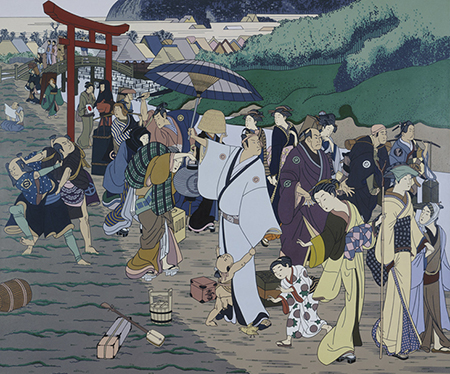
On view indefinitely
The re-installation of the American art collection at Seattle Art Museum reflects significant shifts in art history, curatorial perspectives, and what is and is not a “masterpiece.” The results are an engrossing experience for visitors new to historical American art and those familiar with tried-and-true (but outdated) lists of the significant, mostly male, American artists since the establishment of the Republic. No one is claiming the SAM’s roster is definitive, or even comprehensive. That could never, and probably never will, be the Museum’s story.
From its beginnings in 1933, the Museum has been an upside-down institution. The traditional hierarchies of European and American painting, sculpture, on down, thanks to founding director Dr. Richard E. Fuller, became the collection’s lowest priority. Dr. Fuller thoroughly supplanted the predominant art historical narrative with Asian art of all types, stripes and colors. Among the top ten American Asian art connoisseurs (along with Avery Brundage and Arthur Sackler), Dr. Fuller and his mother travelled on shopping sprees to the Orient throughout the 1920s and 1930s. Through them the Museum snapped up everything from devotional Buddhist art, Hindu deities, and Thai bronzes, to Chinese jades and bronzes, and Japanese porcelain and textiles.
Therefore, when Ann M. Barwick Curator of American Art, Theresa Papanikolas, arrived five years ago, she had her work cut out for her: how to make a spotty and meager (by national standards) American art collection look significant and refreshed. To be fair, thanks to Microsoft co-founder Paul Allen, a few genuine masterpieces had been added, along with other key works by Albert Bierstadt, John LaFarge, and John Singer Sargent. Mid-twentieth-century modern art, not on view in this survey, was taken care of by the generosity of New York School collectors Virginia and Bagley Wright. That left the entire rest of the preceding two centuries and three other persistent but thorny problem areas: Asian-American art; Hispanic-American art; and the art of Indigenous Americans. This time around, all three have been integrated into the wider, more complete tale of American art history. With this reinstallation we get several surprises and, in general, it works. Issues of both breadth and depth are meaningfully addressed.
Besides Dr. Fuller’s obsession with jade snuff bottles and Sung Dynasty vases, Weyerhaeuser timber executive John Hauberg assembled an enormous collection of Northwest Coast Native Art that has its own wing. Similarly, thanks at least to Dr. Fuller’s obsessive Asia-philia, three central modernist painters of the 1930s, Kamekichi Tokita, Kenjiro Nomura, and George Tsutakawa, were acquired early on, and as a result some of their very best pieces are on view. Subject area titles such as “Reimagining Regionalism,” “Transnational America,” and “Storied Places” accommodate treasures that Hauberg collected and seamlessly integrate new acquisitions and special commissions from Native American artists such as Wendy Red Star. Papanikolas is helped by guest curators of diverse backgrounds, and in-house Native American Art curator Barbara Brotherton. With extensive wall texts and labels, as well as shrewdly placed video interviews shown on discreet smaller screens, viewers gain a much larger overview of how American art developed before and after the European and Asian encounters on this continent.
More a Whitman’s sampler than a full-course meal, ”The Stories We Carry” nonetheless includes 89 objects of silver, wood, ceramic, metals, weaving, oils on canvas, and photography. American art covers a much longer timespan now — newer and different, long overlooked, artists and art needed to be represented.
As a result, shiny English silver is shown alongside Tlingit woven baskets from Alaska; Mexican scene paintings of the 1930s are seen next to Northwest School working-class portraits by Mark Tobey and William Cumming. Both pairings are shown to advantage, but with unexpected examples. Papanikolas feels no pressure to replay the ten greatest hits of the Northwest School from the permanent collection — Tobey, Cumming, Morris Graves, and Kenneth Callahan. What she does is to insert their works into a rich tapestry of varied artworks rather than asking them to carry the brunt of the heavy lifting. Their wide recognition an established fact, top tier works can begin to take their place as part of a much larger tapestry.
Conservative landscape enthusiasts will not be disappointed by the presence of classic Yellowstone School and Hudson River School masters like Bierstadt, Frederic Church, Robert Gifford, John Kensett, and Cleveland Rockwell, all of whom contribute scenic paintings of the Pacific Coast. They are joined by a couple of American Impressionists, Willard Metcalf and Childe Hassam, both of whom studied in France and were befriended by Monet.
Rustic regionalist Callahan’s “Logging Rail Road Construction” (1937) is paired with “Coulee Dam Construction” (1939) by Z. Vanessa Helder. The pairing reminds us that, at the time, the Coulee surpassed in size any other hydroelectric dam in the world (to the consternation of Joseph Stalin). Without diminishing the Northwest School, “Minidoka Series #2: Exodus” (1978) by Roger Shimomura transforms the deportation of Japanese-Americans to internment camps during the Second World War by depicting the entire scene as if it were occurring in Samurai Japan. There are swords and kimonos, replete with children about to be attacked. Such vivid juxtapositions are among “The Stories We Carry’s” greatest strengths.
